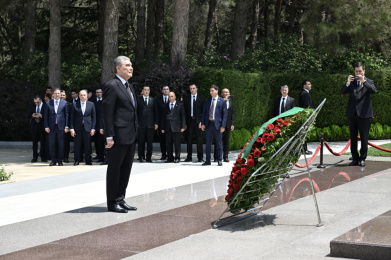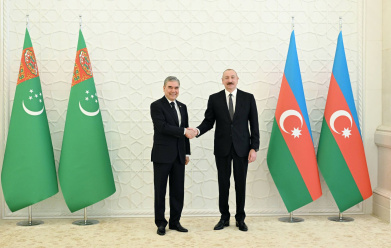If there were no “celestial horses”...
04.07.2018 | 16:43 |Bekdurdy AMANSARIYEV
If I close my eyes and think about the Akhal-Teke horses, I immediately see them, running from the depths of the centuries across the endless sky through Time and Space. Probably, it is in the genes of every Turkmen: although most of us, city dwellers, will not be able to perform the most elementary action – ride a horse (which, alas, has been replaced by a car), but in our sleep, provided that we are happy, we often see the “heavenly horses” that capture with their magic of beauty.
Realizing that history does not have a subjunctive mood, I still tried to imagine how our life would develop, if (God forbid) the Turkmens did not have Akhal-Teke horses?
The history of a humankind is, unfortunately, a continuous series of wars. Even in school textbooks (at least, according to which many of us studied), the past of a humankind was described not as an aspect of development of material and spiritual culture, but as a history of bloody battles. And, sad as it may seem, on the whole planet, it seems to me, it is difficult to determine a more or less long period of time during which a humankind has managed to avoid the local wars.
In this situation, the advantage was given to those who had better weapons and reliable means of transportation. And since the scientific and technological revolution is the brainchild of just the last six or seven decades, during many centuries, a huge role in the political picture of the world was given to the cavalry, in which, taking into account the speed and endurance, the value of the Akhal-Teke horses was inestimable.
And it all began with the fact that, in Central Asia, there were the most favorable natural and climatic conditions that contributed to the formation and development of a unique wild horse – the ancestor of the Akhal-Teke breed. Firstly, plants valleys that rich in high-nutrient bean and cereal and protected from cold winds in winter. Secondly, the abundance, even in the hot summer season, of juicy grasses in the foothills and mountains. Thirdly, the presence in our region of large predators – leopards, wolves and tigers (in the past there were such), which required horses (no great loss without some small gain) always be on the alert, quickly run in a very rough terrain, be dodgy, etc.

Life in a warm climate with a rich food reserve and the need to “pull foot” quickly in dangerous moments involved successfully the mechanism of natural selection that contributed to the development and consolidation of remarkable qualities in the faraway ancestor of modern Akhal-Teke horses, and nowadays they delight the connoisseurs of equestrian.
Here, in Central Asia, in the opinion of many specialists (V.V.Bartold, B.A.Kuftin, etc.), the domestication of a wild horse occurred. Professor O.A.Gundogdyev believes that the domesticated horse had already existed in the lifestyle of the ancient country Margush inhabitants in Turkmenistan in the first half of the IV millennium B.C., which is confirmed by the recent findings of Professor V.I.Sarianidi during excavations of the imperial tomb of ancient settlement of Gonurdepe, the capital of Ancient Margush, where a burial of sacrificial colt, most ancient in Central Asia and Near East. were discovered. In addition, archaeologists have discovered a bronze sculpture in the form of a horse’s head, outwardly reminiscent of Akhal-Teke’s signal pipes – wind musical instruments, which were used for training horses, etc.

These and other findings gave scientists reason to conclude that at the turn of the III-II millennium BC, that is, over 4 thousand years ago, the ancestors of Turkmen were engaged in horse breeding. Subsequently, they (in practice proved that they are outstanding national breeders) not only carefully preserved, but also developed remarkable natural qualities of the Akhal-Teke breed of horses.
The use of a horse as a means of transportation, which contributed to a significant reduction in distances and consolidation of differentiated nomadic tribes into large tribal unions was an important moment in the history of a humankind. It is enabled our ancestors to expand the geography of their possessions.
Thus, in the vast expanses of the Eurasian continent, the victorious march of the remote ancestors of the Turkmen – Huns, Scythians, Saks, Massagets, and others – began. The “war wagon” (horses chariots) – weapon unknown to no one – was the basis of their troops at that time. Such perfectly remains of cart with bronze rims on wheels were also discovered during archaeological research on the territory of Ancient Margiana, recognized by the world’s largest scientists as the fifth center of world civilization.

It is interesting that at that time, in the Asian Near East, the Aryans founded the state of Mittani, where a completely new tactic of fighting with the use of wagons was widely used, and in Asia Minor – the Hittite state, where, according to the ruler, there were “horses more than straws”. There is a clearly visible “continuity link” between these states and Turkmenistan, in particular, in the training of horses. This conclusion can be reached by studying the Hittite “Treatise on horse breeding”. And if we consider this issue in a broad aspect, then, according to Professor S.N.Bogolyubsky, in general, Central Asian culture (especially Turkmen) is closest to the ancient Mittani and Hittite cultures.
At dawn of ancient civilizations, Akhal-Teke horses reached Egypt, where Pharaoh Thutmose III, during his successful campaign against Syria and Palestine, used “500 selected chariots harnessed by fast, like the wind, horses.” The question arises: could the Egyptians have won such a number of bright victories, if they had not such a formidable army for their time, the most important type of troops in which was the cavalry?
The martial Romans also could not held their numerous campaigns without the Akhal-Teke horses. Thus, from Asian Near East and Egypt to ancient Rome, as well as to Greece, this “noble horse of Central Asia, immortalized in the portraits of the great masters of Assyria, Egypt and Hellas” came.
Solomon, the ruler of Israel, who lived in the X century B.C., apparently realizing the power of the Scythians’ warrior – the ancestors of the Turkmens – strengthens his troops with swift-footed horses, whose description in the Bible resembles the Akhal-Teke horses. The legendary prophet and king bought a large number of chariots and wonderful horses, the best of which he could buy in the capital of the Parthian state – Nisa, located on the territory of the present Ashgabat.

Alexander of Macedonia, later known as Alexander the Great, who passed through the lands of the Turkmen with fire and sword, obtained 4 thousand horses for his famous cavalry, “there is no like this in no one country: they are ardent, very fast and enduring.” The greatest conqueror of the universe had a famous horse named Bucephalus, who served Alexander the Great in most critical battles. Many experts believe that Bucephalus was from the breed of horses that were bred in the valleys of Nisa. And when Bucephalus died due to fatal injuries at the Battle of the Hydaspes, India, (June 326 BC), in which Alexander’s army defeated King Porus. Alexander arranged a lavish funeral for his beloved horse and promptly founded a city, Bucephala, in honour of his horse. It lay on the west bank of the Hydaspes River (modern-day Jhelum in Pakistan). The modern-day town of Jalalpur Sharif, outside Jhelum, is said to be where Bucephalus is buried.
It is time to ask a question. Are known other breeds of horses in honor of which cities are named?
Or another, much general question. Is there any other horse on our planet that could become the personification of the culture of the people, like the Akhal-Teke horse for the Turkmen?
Thus, already mentioned Professor S.N.Bogolyubsky, referring to ancient Parthia, enthusiastically wrote: “Looking at the famous Akhal-Teke horses, we see them as distant glorious culture of disappeared States.” As to ancestral home of the “heavenly horses”, Professor M.E.Masson pointed out that “an ancient form of Nisa horses, unusually tall, long-legged, slim in build with exceptional agility and ability to endurance over long distances (up to a hundred and fifty kilometers), had to develop in conditions of exceptionally spacious plains, which requirements are more satisfied in Parthian Nisa.” The founder of the Soviet zoo technical science professor M.Pridorogin wrote about the Akhal-Teke: “The one who has seen the Turkmen horse; he really enjoyed the real beauty.”

... When the mobile units of nomads began to disturb the borders of the Celestial Empire, the Chinese ruler was forced to carry out military reform, for which he undertook many diplomatic and military efforts to get swift-footed argamaks, as well as seeds of alfalfa, in order to cultivate a valuable forage culture in China itself for a balanced diet of “Heavenly horses.”
According to legends that have reached us, Oguz Khan, the ancestor of the Turkmen nation, was obliged to a fast-moving horse for the fact that he stayed alive. Later, Oguz Khan, according to Chinese sources, skillfully used the tactics of military operations, well approved by the cavalry of the Scythians, which helped him create a huge and powerful empire:
“Thanks to the mercy of Heaven, the commanders and soldiers were in good condition, and the horses are strong, which enabled me to destroy the Yueh-chih, who were killed or surrendered. I also pacified Lolan, Usun, Huiji, and twenty-six (!) other neighboring territories ... So, all the nations that were bending bows were united into one family.”
Among scientists, there is still no consensus on what place and when the cataphractarium knights originated. Professor O.Gundogdyev quite reasonably believes that it happened on the territory of present-day Turkmenistan, for “the heavy cavalry, along with the light one, was characteristic of the ancestors of the Turkmen.” He comes to this conclusion, relying on many facts: the image of a horse, “dressed” in armor, fixed on a fragment of painted ceramics; figures of “armored” horses found during the excavations of the New Nisa, Parthian capital, located on the territory of the present Ashgabat.

The Parthians, armed with a heavy, “knight” cavalry and light cavalry, defeated the army of Mark Crassus in 53 BC, who known in history as a Roman general who suppressed the Spartacus uprising. The Parthians killed Krass himself during the battle, and 10 thousand captured Romans (a third of their troops) was sent to a settlement of Merv. Of course, the ancestors of Turkmens – the Parthians achieved such successes in military largely thanks to the well-trained fighting horses.
When bellicose Arabs arrived on the territory of our country, the rare Turkmen population living in the steppe, as the outstanding scientist LN.Gumilev writes, “was enough to stop the Arabian onslaught,” which was largely due to the fighting qualities of the Turkmen horses, The Arabs were amazed a lot. Since that time, the mass export of Akhal-Teke horses to the Arabian Peninsula, and from there to Europe, has started, which has brought to life one more “name” of the Akhal-Teke horses - the “Arabian horse.” By the way, the same historical incident occurred with the Turkmen national carpets that exported to Europe via Iranian, Afghan and Bukhara markets, which is why they were called not the Turkmen but the Persian, Afghan and Bukhara carpets in the Old World.
It is well-known fact that one of the foundation stallions of the English purebred “Arabian stallion” was a thoroughbred Akhal-Teke. Another well-known foundation stallion at stud farms of Prussia was called Turmen-Ati (which translates “Turkmen horse”), whose origin can be determined even by his nickname. So, thanks to “celestial horses” horses of Arab and English breeds, the purest descendant of the which is the Akhal-Teke, came on the historical arena.

Later, in the 11th century, our ancestors, skillfully using cavalry during their campaigns, create a powerful Seljuk empire, after which the Turkmens, according to the outstanding Orientalist V.Barthold, “acquired for the Muslim world such importance as no one of other Turk peoples had in the Middle Ages.” At that time, the Turkmen soldiers, whose main strike force were “flying” cavalry units, subdued Central and Asia Minor, Trans Caucasus and Middle East, defeated a formidable rival – the Byzantine Empire, whose ruler was captured by the Turkmen. All this contributed to the fact that the Seljuk state became one of the strongest in the history of the world powers.
Akhal-Teke horses played their role during the Crusades, when the knights, who were armored, performed a series of military campaigns to discourage the “infidels” from the Holy Sepulcher. Thus, in the literature, the episode of the battle during the Third Crusade is described, when a swift attack by the Turkmen cavalry drove away from Jerusalem the knights of Richard I, who was trying to take possession of the holy city.
And when the hordes of Genghis Khan conquered the Central Asia, the horse of the so-called southern type began to disappear gradually – it was replaced by a horse of the steppe type. The Turkmen, however, having waged an unequal struggle with the aggressor, managed to preserve their national pride – the Akhal-Teke horse. The “volatile” detachments of Turkmen dzhigits unexpectedly attacked the Mongolian troops and, after inflicting considerable damage to the enemy, immediately disappeared, dissolving in the mirages of the hot sands of the Karakum desert.
Dmitry Donskoy, son of Ivan II, Prince of Moscow and Grand Prince of Vladimir, the first of the Russian rulers realized that the only way to fight successfully against Mongolian hordes is to have a light cavalry. Since then, the purposeful import of Argamaks to Rus has begun. Moreover, “probably, light cavalry predetermined the outcome of the Battle of Kulikovo in 1380.” It is known that Mstislav the Daring – the Grand Prince of Kiev – thanks to the Akhal-Teke horse managed to escape from the Mongolian pursuit, and then successfully cross the stormy waters of the Dnieper.
Babur, who founded the empire of the Great Moguls on the site of the Delhi Sultanate destroyed by him, constantly used the Turkmen cavalry to his army. There is list of many Turkmen military commanders and well-known soldiers in his work “Babur-name.”
The rulers of neighboring countries often used riders of Turkmen tribes as mercenaries, considering them to be very skilful warriors. Turkish historian A.Ozirimli also wrote with enthusiasm about the Turkmen cavalrymen:
“Their (Turkmen) tireless horses remained always cheerful in the battle, which in itself played a huge role in the great battles of the nomads. Accustomed to maneuver independently, the horses provided victory to the owners. All the tactics of the soldiers were focused on the horse.”
Many good words about the Turkmen dzhigits (in the Russian literature they are called “Tekintsy”) and their horses – loyal military assistants – was said during the First World War, which is described in detail in the monograph of Professor O.Gundogdyev “The Teke horse regiment: glory and tragedy.”

Despite the heroism of the Turkmen equestrians during the Great Patriotic War of 1941-1945, they could no longer significantly influence the course of military operations, as in the previous epochs, since military technical means of transport come to the forefront. Nevertheless, even a brief and short list of individual episodes from the history of the pride of the Turkmen people, the Akhal-Teke horse, demonstrates the outstanding role played by this breed of horses in the history of all a humankind.
... Perfectly understanding that history does not have a subjunctive mood, I still took the liberty of presenting a picture of what would have happened to us if nature had not shown great generosity by presenting the Akhal-Teke horse to people. And I come to the conclusion that the history of a humankind would be different.
It is hard to believe, facts are not only stubborn things, but conspicuous also…













